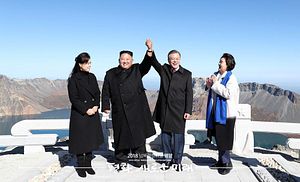At first glance, amid the pomp and circumstance of the summit extravaganza, the Pyongyang Declaration appears to break new ground in inter-Korean relations. But a closer look leaves one with a sense of déjà vu. Indeed, much of the Declaration has been covered in previous inter-Korean agreements.
It encompasses grandiose pledges of peace and tension reduction while avoiding specifics of how North Korea will come into compliance with UN resolutions as well as its many denuclearization pledges in previous international agreements. Consistent with previous inter-Korean summit statements, the latest iteration:
- Pledges additional South Korean largesse to the North — though this would violate UN sanctions;
- Adopts North Korean-inspired language of national self-determination of the Korean Peninsula to downplay U.S. involvement;
- Agrees to tension-reducing measures, though it is only Pyongyang that threatens and attacks its neighbor;
- Continues to use vague and highly conditional terms to dodge Pyongyang’s requirements under 11 UN resolutions to unilaterally abandon its nuclear, missile, and biological and chemical weapons programs in a complete, verifiable and irreversible manner.
- Includes terse references to denuclearization so as not to single out North Korea — and even then, only at the end of the document as if they were an afterthought or an unpleasant distraction from the agreement’s overall more positive tone.
South Korean President Moon Jae-in makes economic promises that he can’t deliver unless the UN and U.S. acquiesce to clear violations of UN resolution sanctions and U.S. laws. Washington was already irritated with Moon’s unbalanced approach of eagerly striving to improve relations with Pyongyang without a commensurate demand for progress in denuclearization. This hardly helps matters.
Security confidence-building measures to reduce the potential for miscalculation and escalation of military hostilities are welcome. But Moon risks going too far by lowering allied defenses before North Korea’s conventional threat to South Korea, and U.S. troops stationed there, is reduced. Moon’s pledge to turn the DMZ and the maritime Northern Limit Line into peace zones could run afoul of UN Command responsibilities to uphold the armistice.
Washington was looking for Moon to deliver on real, tangible, and unambiguous North Korean commitment to abandoning its nuclear and missile arsenal. The Pyongyang Declaration failed to bridge the gap between diverse North Korean and U.S. definitions of “denuclearization” or delineate steps the regime would take. Seoul increasingly sees denuclearization as a U.S.-North Korea issue rather than one shared by all UN nations.
The summit communique had a weaker and more conditional denuclearization pledge than that which North Korea had agreed to 13 years to the day earlier when it “committed to abandoning all nuclear weapons and existing nuclear programs and returning, at an early date, to the Treaty on the Non-Proliferation of Nuclear Weapons and to IAEA Safeguards” in the September 2005 Six Party Talks Joint Statement.
The regime continues to put the onus on the United States to take appropriate, though unspecified, measures first. In the past, Pyongyang claimed that the greatest impediment to resolving the nuclear issue was U.S.-South Korean joint military exercises. Having pocketed Trump’s concession in Singapore to cancel the exercises, the regime now argues that a peace declaration ending the Korean War is required before it will implement any steps toward denuclearization.
However, a peace declaration with North Korea would be a historic but meaningless feel-good gesture that would not improve the security situation on the Korean Peninsula. It would not reduce the North Korean military threat to the allies or alleviate distrust and suspicion. It would only provide an amorphous hope that relations with North Korea will improve and that Pyongyang will be induced to undertake more benign policies.
The Trump administration now faces the dilemma of enforcing principles and risking strained relations with Seoul, or boarding the euphoric peace train. President Donald Trump seems pulled in both directions. He has expressed both unrealistic claims of what the Singapore summit accomplished, as well as subsequent disappointment in the lack of tangible progress.
Trump’s quick positive response to the Pyongyang Declaration suggests that the inter-Korean summit provides enough façade of momentum to justify convening a second Trump-Kim meeting. Trump touts his strong personal relationship with Kim and likely sees it as a way to jump-start stalled denuclearization negotiations.
Yet it would be premature to again rush into another summit meeting without sufficient planning. Doing so runs the risk of yet more U.S. concessions without reciprocal North Korean actions. Instead, newly appointed Special Envoy Stephen Biegun should first meet with North Korean counterparts to work toward a carefully crafted agreement that includes clearly delineated requirements and robust verification.
Pragmatic diplomacy, coupled with maximum pressure and sustained deterrent capabilities, provides the best opportunity to resolve the long-standing North Korean nuclear problem. Spurring Pyongyang to faster denuclearization while counseling Seoul to adopt a slower pace could be Washington’s greatest challenge.
Bruce Klingner, a senior research fellow for Northeast Asia at The Heritage Foundation, previously served as CIA’s deputy division chief for Korea.

































